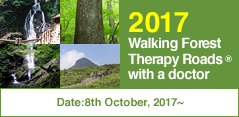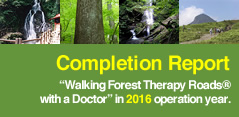New paper in Forest Medicine
Last Updated: April 04, 2011
Recently, a new paper in Forest Medicine has been published in European Journal of Applied Physiology by Springer as follows:
Li Q, Otsuka T, Kobayashi M, Wakayama Y, Inagaki H, Katsumata M, Hirata Y, Li Y, Hirata K, Shimizu T, Suzuki H, Kawada T, Kagawa T.
Acute effects of walking in forest environments on cardiovascular and metabolic parameters.
Eur J Appl Physiol. 2011 Mar 23. [Epub ahead of print]
In the present study, the authors investigated the effects of walking under forest environments on cardiovascular and metabolic parameters. Sixteen healthy male subjects (mean age 57.4 ± 11.6 years) were selected after obtaining informed consent. The subjects took day trips to a forest park in the suburbs of Tokyo and to an urban area of Tokyo as a control in September 2010. On both trips, they walked for 2 h in the morning and afternoon on a Sunday. Blood and urine were sampled on the morning before each trip and after each trip. Blood pressure was measured on the morning (0800) before each trip, at noon (1300), in the afternoon (1600) during each trip, and on the morning (0800) after each trip. The day trip to the forest park significantly reduced blood pressure and urinary noradrenaline and dopamine levels and significantly increased serum adiponectin and dehydroepiandrosterone sulfate (DHEA-S) levels. Walking exercise also reduced the levels of serum N-terminal pro-B-type natriuretic peptide (NT-proBNP) and urinary dopamine. Taken together, habitual walking in forest environments may lower blood pressure by reducing sympathetic nerve activity and have beneficial effects on blood adiponectin and DHEA-S levels, and habitual walking exercise may have beneficial effects on blood NT-proBNP levels.


